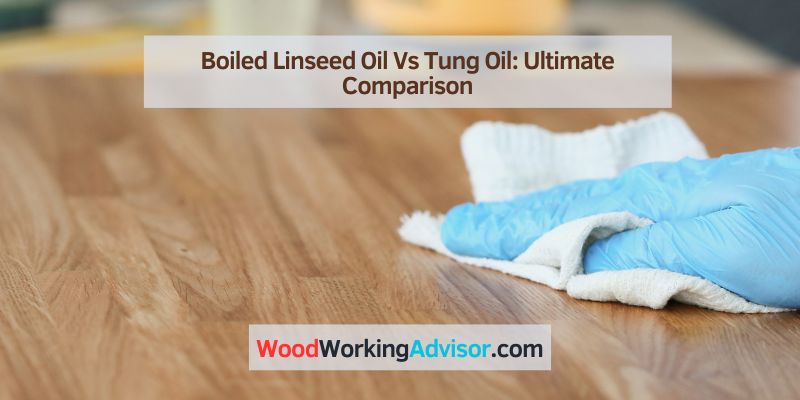Boiled linseed oil and tung oil are natural wood finishes that offer different benefits. Boiled linseed oil provides a more amber hue and dries faster, while tung oil provides a more natural, lighter finish and greater water resistance.
Both oils penetrate the wood to protect and enhance its natural beauty. When choosing between the two, consider the desired color and level of protection for your project. Understanding the characteristics and applications of these oils can help you make an informed decision for your woodworking or finishing needs.
This article will compare boiled linseed oil and tung oil in terms of uses, application, advantages, and drawbacks, to help you make an informed choice for your specific project.
Understanding Boiled Linseed Oil
Origins And Composition
Boiled linseed oil has been in use for centuries, dating back to ancient times when it was used for various applications, including preserving wood and as a drying oil in paintings. This oil is derived from the seeds of the flax plant, with the boiling process enhancing its drying properties. The composition of boiled linseed oil consists primarily of linolenic, linoleic, and oleic acids, making it an effective wood treatment option.
Applications In Woodworking
Boiled linseed oil is widely utilized in woodworking due to its ability to enhance the natural beauty of wood while providing durable protection. Some common applications include:
- Sealing and protecting wooden surfaces
- Enhancing the grain and color of the wood
- Providing a water-resistant finish
- Emphasizing the natural textures of the wood
Woodworkers often rely on boiled linseed oil to bring out the richness of wood and provide long-lasting protection against environmental elements. Its versatile nature makes it a popular choice for both indoor and outdoor wood projects.

Understanding Tung Oil
Tung oil, derived from the nut of the tung tree, is a popular choice for woodworking projects due to its durability and beautiful finish. Understanding the origins and applications of tung oil can help woodworkers make informed decisions about when and how to use this versatile natural finish.
Origins And Composition
Tung oil, also known as China wood oil, is extracted from the seeds of the tung tree (Aleurites fordii). The tree is native to China and has been cultivated for its oil for centuries. Tung oil is made up of triglycerides, which are compounds containing three fatty acid chains bound to a glycerol molecule. This composition gives tung oil its unique properties, including excellent water resistance and deep penetration into wood fibers.
Applications In Woodworking
Tung oil is prized for its ability to enhance the natural beauty of wood while providing a durable, long-lasting finish. It is commonly used as a standalone finish or as an ingredient in oil-based varnishes and paints. Woodworkers often prefer tung oil for indoor furniture, cutting boards, and other food-safe woodworking projects due to its non-toxic nature. Additionally, tung oil can provide a protective layer against moisture, making it suitable for outdoor applications such as garden furniture and wooden decks.
Differences Between Boiled Linseed Oil And Tung Oil
When it comes to choosing the right wood finish, the debate between boiled linseed oil and tung oil often arises. Both oils have their unique characteristics and benefits, making it essential to understand the differences between them before deciding which one to use for your woodworking project.
Drying Time Comparison
Boiled linseed oil is known for its relatively slow drying time, often taking several days to fully cure. On the other hand, tung oil has a faster drying time compared to boiled linseed oil, typically taking around 12 to 24 hours to dry to the touch. This makes tung oil a preferred choice for projects that require quicker turnaround times.
Durability And Protection Comparison
When it comes to durability and protection, tung oil usually outperforms boiled linseed oil. Tung oil forms a hard and durable finish that provides excellent resistance to water, alcohol, and food acids. Conversely, boiled linseed oil offers moderate protection but may lack the long-term durability provided by tung oil, making it more susceptible to wear and tear over time.
Ease Of Application And Maintenance Comparison
Both boiled linseed oil and tung oil are relatively easy to apply. However, tung oil requires fewer coats to achieve a satisfactory finish compared to boiled linseed oil. Additionally, tung oil is known for its self-repairing properties, making maintenance easier over the long term. Boiled linseed oil may require more frequent reapplication to maintain its protective properties, adding to the overall maintenance effort required.
Best Uses For Boiled Linseed Oil And Tung Oil
When it comes to finishing wood, the choice between boiled linseed oil and tung oil can be a crucial decision in achieving the desired result. Each oil has its own unique properties and applications, making them suitable for different woodworking projects. Understanding the best uses for boiled linseed oil and tung oil can help you make informed decisions when it comes to treating and protecting your wood projects.
Boiled Linseed Oil: Optimal Applications
Boiled linseed oil is a versatile finish that has been used for centuries to nourish and protect wooden surfaces. Its fast-drying nature and ability to penetrate deep into the wood make it an ideal choice for certain applications.
- Sealing outdoor wood furniture and decking
- Enhancing the natural beauty of interior wood surfaces
- Protecting and revitalizing antique furniture
- Sealing and conditioning wooden tool handles
Tung Oil: Optimal Applications
Tung oil is a natural, hard-drying oil that provides a tough, lustrous finish to wood. It is well-suited for specific uses due to its unique properties.
- Creating a water-resistant finish for outdoor wooden surfaces
- Protecting and enhancing the grain of fine woodworking pieces
- Finishing cutting boards and kitchen utensils for food-safe surfaces
- Preserving and beautifying hardwood floors
Frequently Asked Questions On Boiled Linseed Oil Vs Tung Oil
What Are The Main Differences Between Boiled Linseed Oil And Tung Oil?
Boiled linseed oil is a popular wood finish, while tung oil is a natural drying oil. Boiled linseed oil offers faster drying time and a shiny finish, while tung oil provides a more natural appearance and better water resistance.
Which Wood Finish Is Better For Outdoor Furniture, Boiled Linseed Oil Or Tung Oil?
Tung oil is a better choice for outdoor furniture due to its superior water resistance and ability to withstand exposure to the elements. Boiled linseed oil, on the other hand, may not provide sufficient protection for outdoor use and can require more frequent reapplication.
How Do Boiled Linseed Oil And Tung Oil Differ In Terms Of Application And Drying Time?
Boiled linseed oil generally dries faster than tung oil, making it a more convenient option for quick project completion. Tung oil requires a longer drying time between coats and may take several days to cure fully. Each oil has different application techniques for best results.
Conclusion
In the comparison of boiled linseed oil vs tung oil, both have their unique benefits. Boiled linseed oil offers a quicker drying time and is cost-effective. Tung oil, on the other hand, provides a more durable finish and is resistant to water and chemicals.
Consider the specific needs of your project before making a choice.



One thought on “Boiled Linseed Oil Vs Tung Oil: Ultimate Comparison”